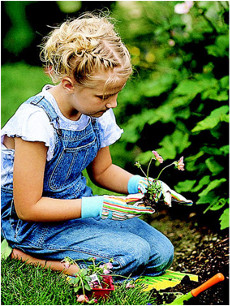Gardening Therapy
/Recent years have seen gardens popping up in some of the most unexpected places - retirement homes, after-school programs, and even prisons - where, it turns out, they have proven to be a very beneficial form of therapy and rehabilitation on multiple levels. Horticultural therapy is a centuries-old practice that began as a treatment for mental illness. Over the last 75 years that net has expanded to include physical rehabilitative care, memory care, and even social and work-related rehabilitation.
The possible benefits of horticulture therapy include improvement in memory, cognitive abilities, language and social skills, as well as coordination, balance, endurance and muscle strengthening. Gardening with purpose also can help teach people to work independently, problem solve and follow directions.
While many therapeutic gardens are designed by landscape architects for clinical application in order to promote a specific set of therapeutic benefits, you too can create your own garden oasis for at-home therapeutic use. The first step is to decide what kind of therapy you want to use your garden for. If you have mobility limitations, an enabling garden with gently graded accessible entrances and paths and raised planting beds may be right for you. If you want to promote learning and memory care, consider incorporating a sensory-oriented plant selection focused on color, texture and fragrance. If you have kids, you may want to consider making your garden a fun place for them to learn and play as well. Give your child a kid-friendly planter and encourage them to plant and maintain their own assortment of flowers and herbs. Hang a tire swing from a tree in your yard for your child to play on. If you want to encourage physical health and nutrition consider producing your own natural food supply, using organic farming principles. Or maybe you simply want a calm place to recuperate after a long day, in which case you may want to consider incorporating plants with calming scents and easy upkeep. No matter what type of therapies you choose to incorporate, the key is to remember that gardening should be enjoyable and beneficial, it should not feel like work. For more ideas on how to make your garden more therapeutic, check out these resources:
- The American Horticultural Therapy Association's characteristics of therapeutic gardens.
- The American Society of Landscape Architects website.
- Healthcare and Therapeutic Design Professional Practice Network's Therapeutic Landscapes Network.
REFERENCES
Photo Credit. Annies Gardens. http://www.annies-gardens.com/5-gardening-tips-kids-apply.html.
Gardeners Hand Care Routine. Garden Therapy.ca. http://gardentherapy.ca/gardeners-hand-care/.
About Horticultural Therapy. American Horticultural Therapy Association. http://ahta.org/horticultural-therapy.
Can Gardening Help Troubled Minds Heal? The Salt. National Public Radio. http://www.npr.org/blogs/thesalt/2012/02/17/147050691/can-gardening-help-troubled-minds-heal.
Characteristics of Therapeutic Gardens. The American Horticultural Therapy Association. http://ahta.org/sites/default/files/attached_documents/TherapeuticGardenChracteristic_0.pdf.
American Society of Landscape Architects. http://www.asla.org/PPNIndividualHome.aspx?id=3308.
Therapeutic Landscapes Network. Healthcare and Therapeutic Design Professional Practice Network. http://www.healinglandscapes.org/.
Image Attribution: Annies garden (http://www.annies-gardens.com)

